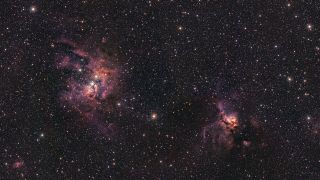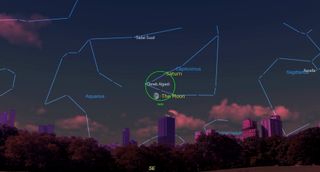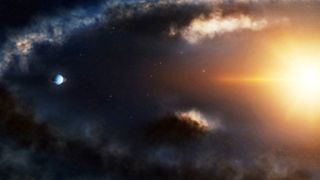Space.com contributing writer Stefanie Waldek is a self-taught space nerd and aviation geek who is passionate about all things spaceflight and astronomy. With a background in travel and design journalism, as well as a Bachelor of Arts degree from New York University, she specializes in the budding space tourism industry and Earth-based astrotourism. In her free time, you can find her watching rocket launches or looking up at the stars, wondering what is out there. Learn more about her work at www.stefaniewaldek.com.
Latest articles by Stefanie Waldek

Winter solstice 2022 brings the longest night of the year to Northern Hemisphere
By Stefanie Waldek published
The winter solstice is today (Dec. 21), marking the official start of astronomical winter in the Northern Hemisphere and the shortest day of the year.

Doom-spiraling exoplanet will someday meet fiery demise
By Stefanie Waldek published
Tidal interactions are pulling the exoplanet toward its demise: a fiery collision with its star.

NASA cancels climate change satellite to monitor greenhouse gases
By Stefanie Waldek published
NASA has canceled the GeoCarb mission, which was a greenhouse gas–monitoring satellite into geostationary orbit.

Baby stars throw cosmic tantrums in iconic James Webb Space Telescope image
By Stefanie Waldek published
Scientists reexamining the James Webb Space Telescope's iconic "Cosmic Cliffs" image of the star cluster NGC 3324, have spotted a rare sight: protostars emitting two dozen powerful jets and outflows.

The Geminid meteor shower peaks tonight. Here's how to see it
By Stefanie Waldek published
The Geminid meteor shower will peak overnight tonight (Dec. 13 and Dec. 14), producing anywhere from 60 to 120 meteors per hour.

NASA's retired flying telescope heads to museum
By Stefanie Waldek published
After eight years of science missions, the Stratospheric Observatory for Infrared Astronomy (SOFIA) aircraft has found permanent residence at the Pima Air & Space Museum in Arizona.

Star may have drawn scorching 'hell planet' into super-close orbit
By Stefanie Waldek published
The super-Earth exoplanet Janssen is so close to its star, a year is only 18 hours long.

With eyes on Mars, NASA algorithm tackles dust devils on Earth
By Stefanie Waldek published
On Mars, dust devils can have both positive and negative impacts on robotic exploration on the planet.

Nebulas glow with forming stars in stunning new image
By Stefanie Waldek published
ESO's Visible and Infrared Survey Telescope for Astronomy gives us a peek at the action inside the stellar nurseries.

NASA water-hunting moon cubesat ready to launch with SpaceX
By Stefanie Waldek published
NASA's Lunar Flashlight mission will deploy a small satellite to skim the moon's surface and use lasers to search for water ice in lunar craters.

Right place, right time: Hubble telescope captured a supernova as it exploded
By Stefanie Waldek published
Archival images from the Hubble Space Telescope have revealed an infant supernova photographed just hours after the star's explosion 11.5 billion years ago.

The origins of Mars' crust might be surprisingly complex
By Stefanie Waldek published
New research indicates that certain areas of the Martian crust have a higher silica content than expected, upending the long-held theory that the crust is uniformly basaltic.

See the first quarter moon join Saturn in the sky tonight (Nov. 1)
By Stefanie Waldek last updated
Catch Saturn making a close approach of the moon in its first quarter phase on Tuesday (Nov. 1).

Something spooky is happening at the edge of the solar system
By Stefanie Waldek published
The boundary between the heliosphere and the interstellar medium appears to be moving in an unexpected manner.

See Saturn's rings in glorious detail in stunning new composite image
By Stefanie Waldek last updated
A newly processed image, comprising 41 observations by NASA's retired Cassini mission, provides insights into the origins of Saturn's rings.

Hubble Space Telescope finds neutron star collision's jet travels nearly as fast as light
By Stefanie Waldek last updated
The Hubble Space Telescope observed the aftermath of astronomers' first-ever neutron star collision and measured how fast the jet produced traveled.

Astronomers discovered something strange about 'potentially hazardous' asteroid Phaethon
By Stefanie Waldek published
The asteroid Phaethon's rotational period is decreasing, which is rare for space rocks.

See the moon and Saturn close together in the night sky tonight (Oct. 5)
By Stefanie Waldek published
Across the United States, the moon and Saturn will appear to be close neighbors for a good portion of the night.

Newborn volcanic island spotted from space (satellite photo)
By Stefanie Waldek published
The NASA-USGS Landsat 9 satellite spotted an eruption at the Home Reef seamount in the Tonga Islands that produced a small island.

Scientists need your help to confirm Jupiter-like exoplanets
By Stefanie Waldek published
Amateur astronomers can help verify discoveries by NASA's Transiting Exoplanet Survey Satellite.

NASA's flying telescope is coming to the end of its mission but leaves a strong science legacy
By Stefanie Waldek published
Since 2014, SOFIA has been cruising through the night skies around the world, looking at the cosmos, but that mission ends this week.

NASA's DART spacecraft will crash into an asteroid tonight in historic planetary defense test
By Stefanie Waldek last updated
On Monday (Sept. 26) at 7:14 p.m. EDT (2314 GMT), if all goes well, DART will crash into Dimorphos in an attempt to alter the moonlet's trajectory.

Mysterious blue blobs a new type of star system created by a galactic 'belly flop'
By Stefanie Waldek last updated
The blobs are irregular groups of young blue stars thought to have formed in a galactic collision that scientists liken to a belly flop.
Breaking space news, the latest updates on rocket launches, skywatching events and more!



